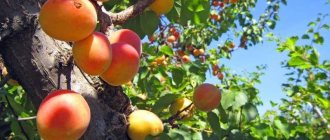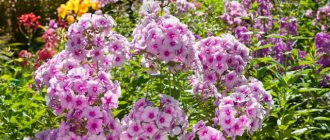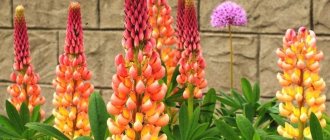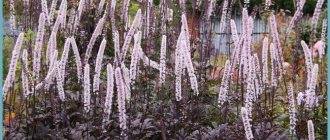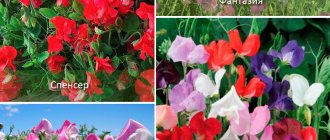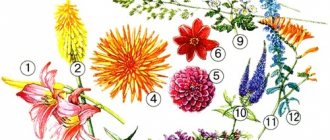The herbaceous annual and perennial plant chrysanthemum (Chrysanthemum) is a member of the Asteraceae family. From Greek, the name of the plant is translated as “sun flower” or “golden flower”; the fact is that in most species the inflorescences are yellow. According to the GRIN website, this genus unites approximately 29 species that are naturally found in the temperate and northern zones, and most often in Asia. Archaeologists are confident that the ancient Chinese grew chrysanthemums more than 2.5 thousand years ago; they ate the petals of this plant. The chrysanthemum was also mentioned by Confucius himself in the treatise “Spring and Autumn”. Later, the Japanese began to grow the plant, who idolized the chrysanthemum so much that only members of the imperial family had the right to wear clothes with its image. The flower appeared in Europe only in the 18th century, but it became popular among gardeners only in the 19th century. Today, the garden chrysanthemum (Chrysanthemum hortorum) is the most popular among gardeners; scientists believe that it was formed as a result of crossing two Asian species: the large-flowered chrysanthemum (Chrysanthemum morifoolium), which is native to China, and the small-flowered chrysanthemum (Chrysanthemum indicum) from Japan . However, some experts believe that the garden chrysanthemum appeared due to the crossing of the Chinese chrysanthemum and the small-flowered Indian chrysanthemum. There are a huge number of chrysanthemum varieties, and breeders are still working on developing new unusual varieties.
Brief description of cultivation
- Landing . In April, seedlings are sown, and in May, the seeds are sown in open soil. Sowing can be done before winter, but no later than 15 days before the first frost.
- Bloom . In the last weeks of summer and autumn.
- Illumination . Needs plenty of bright sunlight.
- Soil . The land should be fertile, dry, well-permeable, neutral or slightly acidic, loamy.
- Watering . Needs abundant watering.
- Fertilizer . Three times during the season, for this they alternately use organic and mineral fertilizers in liquid form. Fertilizers are applied to the soil for the first time seven weeks after planting.
- Reproduction . Annual species and varieties are propagated only by seeds, and perennials - mainly by cuttings and dividing the bush.
- Harmful insects . Nematodes, aphids, meadow bugs.
- Diseases . Gray rot, rust, septoria, powdery mildew, bacterial root canker.
Features of chrysanthemum

Chrysanthemums are represented by perennial or annual subshrubs and herbaceous plants. The branched rhizome grows parallel to the soil surface. The surface of the stems may have pubescence, but they may also be bare. Simple alternately arranged bare or pubescent leaf plates differ in size and shape: jagged, notched or dissected. As a rule, the foliage is greenish in color, but it can also be dark green. Most often, small flowers are part of an inflorescence-basket, which in some cases can be quite large. The basket consists of single-row reed-shaped marginal and central tubular flowers, but in most hybrid varieties they are arranged in multi-rows, resulting in the formation of a lush inflorescence called terry chrysanthemum. The fruit is an achene. Today, gardeners cultivate varieties and species of the so-called mulberry chrysanthemum, or garden chrysanthemum. It is also sometimes called Chinese chrysanthemum. This group of varieties and hybrids is very complex, and they also have a complicated history.
Chrysanthemums. Features, care and reproduction
Popular varieties of green chrysanthemums
Unlike the “autumn queens” of other colors, numbering thousands of varieties, there are not so many green chrysanthemum bush varieties. Among them there are varieties representing families of similar appearance, but different colors. In such cases, the name is often attributed to the words “green” - green or “green dark” - dark green. For example, the name of the chrysanthemum Green Lizard Dark means that its color in this case is rich and dark.
Today the most widespread varieties are:
- Bush chrysanthemum Code Green is a new product of Dutch selection, with large pompom malachite inflorescences 7-8 cm in diameter on beautifully branching strong and elastic stems. The height of the bush is 60-70 cm. Retains freshness when cut for up to 3 weeks.

Chrysanthemum "Code Green" - Bush chrysanthemums Green Lizard (chrysanthemum Green Lizard) is another hybrid variety of Dutch selection, with chamomile inflorescences 6-7 cm in diameter and petals of a rich light green color. The height of the bushes reaches 130 cm. Flowering is mid-late. Keeps well when cut.

Chrysanthemum "Green Lizard" - Bush chrysanthemum Rhythm (chrysanthemum Rhythm) is a hybrid cut variety of Dutch selection with needle-shaped inflorescences with a diameter of 7-8 cm. The color of the petals is soft herbal. The height of the bush is 70-80 cm. It tolerates transportation well and retains freshness in the bouquet for a long time.
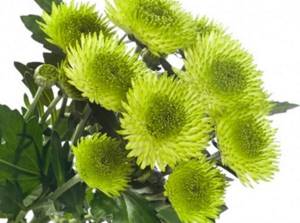
Chrysanthemum bush "Rhythm" - Froggy (chrysanthemum Froggy Green, Froggy Green Dark) is a cut variety with small spherical inflorescences with a diameter of 3-4 cm. The bush is 50-60 cm high. It is stable in cutting. Used to compose floral compositions as a basis or addition to a bouquet. Flowering occurs in October.
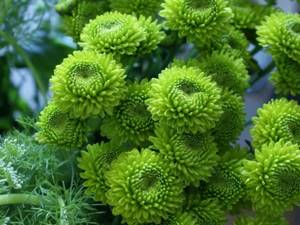
Chrysanthemum "Froggy" - Balls (chrysanthemum Green balls) - Dutch spherical small-flowered variety. There are 6 small inflorescences on the stems. Their diameter is up to 4 cm. The height of the bush is about 60 cm. It retains freshness for a long time when cut.

Chrysanthemum "Green balls" - Button (chrysanthemum Green button) - plants with small, compact, slightly flattened hemispherical double inflorescences, shaped like buttons with a diameter of 3-4 cm. On stems about 60 cm high, 4-7 flowers open. Used as a basis for bouquets and floral arrangements.
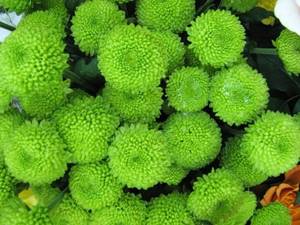
Chrysanthemum "Green Button" - Bomber Green (chrysanthemum Bomber green) is a large-flowered terry bush beauty. Narrow long petals grow, bending upward, and completely cover the core. Bomber Green basket inflorescences reach a diameter of 10-12 cm and are distinguished by their spectacular poisonous color. The stem is strong and powerful. The height of the bush is 70-80 cm. When cut, it lasts up to 3 weeks.

Chrysanthemum "Bomber Green"
All articles about chrysanthemums on the site can be read by following this link...
A chrysanthemum with green petals is always an extraordinary phenomenon in a bouquet, any other floral arrangement or in a flower bed in the garden. Possessing a dull color, it invariably attracts the eye and arouses interest.
Growing chrysanthemums from seeds
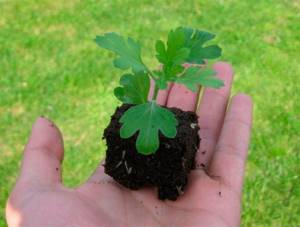
Sowing in the ground
The easiest way to propagate chrysanthemums is by dividing the bush and cuttings. However, very often, a chrysanthemum grown from a seed becomes the pride of a gardener. Seeds are used to propagate both annuals and perennials, for example, Korean chrysanthemum. Below we will talk about growing such a flower from seeds using annuals as an example.
In May, after the return frosts are left behind, planting holes must be made on the site, the distance between which should be from 20 to 25 centimeters. They are spilled with lukewarm water and 2 or 3 seeds are placed in them. When the holes are filled with soil, you need to cover them on top with garden film, thereby you will be able to retain the moisture and heat necessary for seed germination in the soil. After the first seedlings appear, the cover is removed, and the surface of the soil in the area is carefully loosened, removing all the weeds. A week and a half after the emergence of seedlings, fertilizing is carried out with a very weak concentration of “Rainbow” or “Ideal” solution.
After the seedlings reach a height of 70 to 100 mm, they are thinned out. As a result, in each hole there should remain one of the strongest plants with 3 or 4 true leaf blades formed. If desired, excess seedlings can be transplanted to another location. Annual chrysanthemums grown from seeds will begin to bloom in August. In order for the bushes to please with early flowering, they are grown through seedlings.
Sowing seedlings
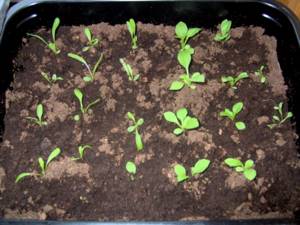
To grow seedlings, you will need low boxes filled with a substrate that includes humus, greenhouse soil and peat (1:1:1). The soil mixture can be bought at a specialized store, where it has already been disinfested and disinfected. The substrate prepared by yourself must be sifted and calcined at a temperature of 110 to 130 degrees. At the bottom of the box, first make a good drainage layer from expanded clay or pieces of brick. It is covered with prepared substrate, and seed material is evenly distributed on its surface. When sowing perennial seeds, they are not poured on top, but only lightly pressed into the soil mixture. And when sowing annuals, the seed material is sprinkled on top with a half-centimeter layer of substrate. Water the crops with a sprayer with lukewarm water and cover the container with film (glass) on top. Place the crops in a warm place (from 23 to 25 degrees), ventilate them systematically and moisten the substrate with a spray bottle, preventing it from drying out. If everything is done correctly, the first seedlings should appear 10–15 days after sowing. As soon as this happens, the box is moved to a well-lit place. The shelter is not removed immediately, but gradually, so that the plant has time to get used to the new conditions. To begin with, the shelter is removed for 1 hour, then for a couple of hours, and so on, until the plants get used to the new growth conditions.
If excessively dense seedlings appear after they have grown, they are planted in individual cups with the same substrate that is used for sowing seeds. This is done after the plants have formed from 2 to 4 true leaf blades; during transplantation, try not to injure their root system. Before starting picking, water the soil mixture in the box generously. During transplantation, discard plants that are too weak and elongated. In order for the seedlings to take root faster, after transplanting they are moistened from a sprayer with a solution of Epin or Zircon.
About sowing in detail!!! We grow chrysanthemums from seeds.
Seedling care

After picking, the seedlings are removed to a cool (16 to 18 degrees) and well-lit place. Watering is carried out only when necessary, and fertilizing is carried out regularly once every 2 weeks, for this purpose a solution of complex mineral fertilizer is used. If necessary, illuminate the seedlings with fluorescent lamps. Remember that seedlings of such a crop are characterized by extremely slow growth, so after 6 weeks their height reaches only about 20 centimeters.
Varieties and varieties of garden chrysanthemums
Garden chrysanthemum is a perennial plant, the height of which depends on the variety and can vary from 15 to 150 cm . Currently, a huge number of varieties of chrysanthemums are known, which, according to some features and characteristics, are combined into groups.
Size of inflorescences
Perennial chrysanthemums are divided into three groups based on the diameter of their flowers:
- small-flowered;
- medium-flowered;
- grandiflora.
Small-flowered or Korean plants can be either simple or double. A significant number of inflorescences grow on one bush with a flower diameter from 2 to 10 cm. The bushes themselves can reach a height of 25 to 120 cm. The leaves of the plant are very reminiscent of the shape of oak leaves. Flowers stand out for their frost resistance, are unpretentious to the composition of the soil and are easy to care for. Their flowering begins in mid-September and continues until frost.
Medium-flowered or decorative chrysanthemums can be grown not only to decorate the garden, but also for cutting. They also grow well in pots at home. They can decorate balconies, loggias and terraces. Ornamental bushes grow in height from 30 to 70 cm, and have a flower diameter from 10 to 18 cm.
Large-flowered chrysanthemums are spectacular tall plants. The length of their stem can reach from 80 to 120 cm in height. They bloom with large flowers with a diameter of 10 to 25 cm. This type of chrysanthemum does not tolerate frost well. Only certain varieties of it can winter in open ground. These flowers are mainly intended for cutting into bouquets.
Shape and height of the bush
According to the shape and height of the bush, garden chrysanthemums are divided into three types, each of which has many varieties.
Tall. The stems of this type of garden chrysanthemum can be quite tall and require support in the form of frames, metal mesh or wooden pegs. Supports are installed during planting of bushes. Plants planted in a group can be used as a hedge. The most popular varieties of tall garden chrysanthemums are:
- “Amber Lady” - the plant is distinguished by inflorescences of a golden hue.
- “Umka” - chrysanthemums with white flowers, the shape of which resembles a pompom.
- "Rosetta's Daughter" is strewn with flat inflorescences with flowers in pink and white shades.
Medium height. Bushes growing from 30 to 50 cm look very impressive both in a flower bed and along paths, fences, and gazebos. With their help, you can realize all kinds of design fantasies. The best varieties of medium-sized garden chrysanthemums are:
- “Zorka” - the plant stands out for its yellow-brown color, which just suits the autumn mood.
- “Dune” is a truly magical variety, the flowers of which can change color during flowering. They bloom yellow-brown, and after a few days they turn yellow-gold.
- “Lily” will help add brightness to any composition with its dark crimson flowers.
Borders. Small plants grow up to only 30 cm in height. This type of chrysanthemum is considered one of the most beautiful garden flowers. Border chrysanthemum bushes have the shape of a ball strewn with small flowers. The most popular varieties in this group are:
- "Varvara" is a plant with delicate lilac-lilac flowers.
- “Evening Lights” - the variety stands out for its scarlet inflorescences, which resemble festive fireworks.
- “Talisman” is strewn with bright beetroot-raspberry flowers.
Flower shape
Garden chrysanthemums have five different types of flower shapes:
- Pom pom flowers are an assembly of reeds that are gathered into a ball resembling a pom pom.
- Anemoid flowers consist of large petals, which are arranged in one, two or three rows. The flowers themselves are small in size and very similar to anemone flowers.
- Single-row and double-row inflorescences are bordered by flowers similar to reeds. In the center of such inflorescences small tube flowers grow. The border of flowers can be arranged in one or two rows.
- Semi-double flowers consist of three rows of reeds that are arranged around a central flower.
- Double inflorescences are similar to semi-double ones, but their flowers are more lush, as they are different in appearance and shape.
Planting in open ground and propagation
What time to plant
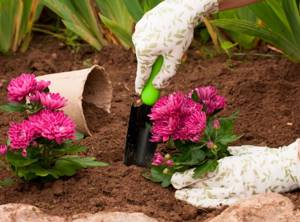
Chrysanthemum seedlings are planted in the spring after warm weather sets in and spring frosts are left behind. As a rule, this time falls on the last days of May or the first days of June. You can plant seedlings in the fall, but no later than half a month before the first frost.
When choosing a site for planting, you need to take into account that the crop loves light and warmth, and it reacts extremely negatively to stagnation of liquid in the root system. In this regard, the site must be elevated, have protection from gusts of wind, and be illuminated by the sun for at least 5 hours a day. It is best if the soil is fertile, loamy, slightly acidic or neutral. Clay or sandy soil must be improved by adding organic matter. However, fresh manure cannot be added to the soil; it should be replaced with vermicompost or humus. Organic matter and mineral complex fertilizers should be added to the soil immediately before planting seedlings. Please note that if there are a lot of nutrients in the soil, then the bushes will begin to actively grow green mass, which will have a very bad effect on flowering.
Landing rules

It is recommended to plant chrysanthemum seedlings in the garden on a rainy or cloudy day. It is more convenient to plant bushes in a trench rather than in planting holes, and a distance of 0.3 to 0.5 m should be left between them (depending on the type and variety). In order for the planted seedlings to take root faster, they are spilled with Kornevin solution (1 gram per 1 liter of water). When the plants are planted and watered, they are pinched, to do this the growing point is removed. Then it is recommended to cover the seedlings with any covering material, for example, lutrasil. This will create a favorable microclimate, which seedlings need for normal rooting and growth. After the chrysanthemum takes root and begins to grow, the shelter is removed.
How to plant chrysanthemums in autumn
Propagation by cuttings

The culture can also be propagated by cuttings. They are harvested in the spring after the air warms up to 21–26 degrees during the day and the return spring frosts have passed. To do this, use a sharp sterilized knife, which is used to cut cuttings from an adult bush, while using those stems that grow from the root of the flower; the lateral shoots are not suitable for this purpose. The cutting should reach 60 to 70 mm in length, and the cut should be made a few millimeters above the bud with the leaf. The lower end of the cutting is treated with a growth stimulating agent, for example, root. After this, it is planted in a container at an angle of 35–45 degrees, which is filled with moistened fertile soil mixture, sprinkled with a two-centimeter layer of sand on top. Plant the cuttings so that they are only in the sand, without touching the substrate. During rooting, the cuttings are placed on a well-lit windowsill, while making sure that the substrate in the container is slightly damp at all times. The optimal air temperature for rooting is from 15 to 18 degrees. If everything is done correctly, the roots will grow after 15–20 days, after which the cuttings are transplanted into open soil.
Gorgeous chrysanthemums - balls How to grow multiflora chrysanthemum from cuttings
Caring for garden chrysanthemum

Even an amateur gardener can grow a chrysanthemum in his garden, but in order for the bushes to be as lush, beautiful and disease-free as possible, you need to know a few tricks. For example, after seedlings planted in open soil have taken root well, become stronger and have formed their eighth true leaf plate, they are pinched to make the bushes more lush. Soon side shoots should appear on the plant, when this happens, they are also pinched, as a result, your area will be decorated with spectacular dense bushes, and when flowers appear on them, they will look like fluffy balls.
When growing large-flowered varieties, you need to pay attention to the fact that it is recommended to remove all side shoots, leaving only a few of the most powerful ones. Cut shoots can be used as cuttings; they give roots very quickly. Some vigorous varieties require support; for this, you can install a net, metal pegs or a wire structure near the bush. It will support the bush and prevent it from falling apart.
Watering

The crop must be watered regularly and abundantly; if the plants do not have enough moisture, then their shoots will become woody and the inflorescences will not be so beautiful. The bushes should be watered with rain or well-settled water (it can be mixed with 2 drops of ammonia). Water is poured under the root, try not to get it on the surface of the leaf plates. After watering, the surface of the earth around the bushes is loosened, and all weeds are removed. In order to make caring for the plant easier, immediately after planting the seedlings, cover the surface of the area with a layer of mulch.
Fertilizer
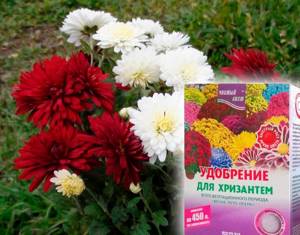
In order for the bushes to grow and develop normally, they are systematically fed. During the growing season, flowers are fed at least 3 times; for this, organic matter and mineral fertilizers are alternately used. At the beginning of the growing season, the bushes need nitrogen; ammonia nitrogen is best suited for this; thanks to this feeding, the bushes will quickly increase their green mass. To stimulate lush flowering, chrysanthemums are fed with potassium-phosphorus fertilizer during the formation of buds.
For feeding, liquid nutrient solutions are used; they are poured at the root of the bushes the next day after watering or rain. The plants are fed for the first time in the first 1.5–2 months after they are planted in open ground. From organic matter, you can use burnt mullein or bird droppings. Experienced gardeners say that it is better not to feed the chrysanthemum rather than to burn it.
Chrysanthemum multiflora, feeding during flowering.
Transfer
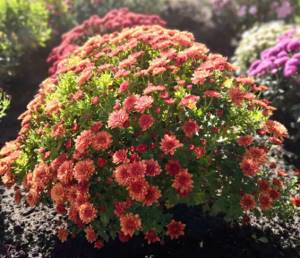
A flower can be grown in the same place for no longer than 3 years, otherwise it will begin to “be capricious”, namely: the inflorescences will begin to shred, and it will also get sick much more often. In this regard, in spring it is necessary to remove an adult bush (over three years old) from the ground and replant it.
As a rule, this procedure is carried out in conjunction with dividing the bush, so that the plant can be propagated. To do this, carefully remove it from the soil, while trying not to injure the root system, and shake off the soil from it. Divide the bush into several sections, each of which should have shoots and roots; for this you can use pruners or a very sharp knife. After this, the divisions are planted in a well-lit area in the same way as seedlings (see above).
Planting a plant
Planting a perennial chrysanthemum must be done correctly, so that later you can provide proper care for it and admire the beauty of the flowering. Keep in mind that only flowers that are resistant to severe frosts typical of winter are planted on a personal plot: zoned varieties and chrysanthemums grown from seeds. It is advisable to plant the remaining varieties in pots as children or seeds. You can use them to decorate your home.
When to plant chrysanthemums in open ground? This is a valid question. Flowers can often be found in stores in the fall, but it is better to plant in the spring. Overwintering a newly purchased plant should be done in pots, otherwise it may simply not withstand the winter, because all the energy will be spent on rooting the flower in the ground. In the southern part of the country, the flower is planted at the end of April or early May, and in the northern part - after spring frosts.
First you need to choose the right place to plant the flower. A prerequisite is excellent illumination, and it is also worth taking care of a sufficient amount of sunlight during the day. Chrysanthemums do not bloom well in the shade: the flowers will become small and the stems will become very tall, as they will stretch high in search of sunlight. It is good when there is protection from the wind, as well as sufficient moisture in the soil (the soil should not be dry all the time, but stagnation of liquid after sowing chrysanthemums should be avoided).
Separately, consider the following soil requirements for planted plants:
- it must allow both air and moisture to pass through;
- the correct soil is loose;
- You can use soil of any type and composition, with the exception of heavy clay;
- It is advisable that the flowers be planted in fertile soil (in poor soil the flowering will be weak);
- choose slightly acidic soil (add peat to the holes during planting and subsequent care of chrysanthemums).
How to plant chrysanthemums correctly? The algorithm is simple and involves the following steps:
- First you need to prepare the holes, the depth of which should be about 40 centimeters. 40 centimeters are left between the holes, and 50 centimeters between the rows.
- At the bottom of each hole you need to lay a drainage layer, for example, made of sand or stones.
- Pour one handful of humus into each hole and water the soil well.
- Plant chrysanthemums so as not to deepen them too much.
- Place stakes nearby that will support the bushes. If necessary (or immediately if the chrysanthemum is tall), you need to tie up the flower.

After planting, you should figure out how to properly care for the plant so that it will delight you with flowering. First you need to pinch the top for better tillering. This is done after the plant has rooted. After three weeks, the pinching procedure is repeated, achieving a spherical shape of the bush. But keep in mind that if the bushes are planted at the beginning of summer, then it is too late to pinch. Leave the single-stem crop, which also looks interesting.
Diseases and pests
Diseases

If you do not adhere to agricultural practices or there are dense thickets of chrysanthemums in your flowerbed, then the risk of them being affected by a fungal disease increases:
- Verticillium wilt . The fungus first enters the root system of the plant. After a while, the foliage of the affected bush turns yellow and the shoots die off.
- Powdery mildew . In a diseased plant, a whitish coating appears on the surface of the foliage, stems, flowers and buds.
- Rust . In the affected chrysanthemum, chlorotic spots form on all its above-ground parts; after a while they become brown, and yellowing of the foliage and thinning of the shoots are also observed.
- Gray rot . Brown spots with blurred edges form on the plant, on the surface of which after some time a fluffy coating appears, which causes rotting.
In order to cure flowers affected by a fungal disease, it is recommended to use products that contain copper, for example, copper oxychloride is very effective in the fight against gray rot, septoria and rust. You can still get rid of rust using colloidal sulfur and copper-soap emulsion, and Bordeaux mixture is used in the fight against gray rot and powdery mildew. For preventative purposes, be sure to provide good care for the flowers, adhere to the rules of agricultural technology and do not allow the plantings to become thicker. Also, regularly inspect the bushes, as this will help identify symptoms of the disease at an early stage.
In some cases, such a plant can infect a very dangerous viral disease:
- Mosaic . A mottled mosaic appears on the surface of the foliage.
- Aspermia . The flowers of the affected bush are deformed, and the foliage becomes speckled.
- Dwarfism . A diseased plant is stunted and blooms prematurely.
All of these diseases today are incurable, therefore, after discovering a diseased bush, it must be removed from the site as soon as possible and burned. For preventive purposes, do not allow harmful insects, which are the main carriers of viruses, to appear on flowers, and also use a sterilized sharp instrument to cut cuttings or divide the bush into parts.
White chrysanthemum rust (Puccinia horiana Henn.)
Pests

Of all insects, nematodes most often damage crops. If they live on a bush, then mosaic spots form on its foliage, and after a while their color becomes darker. It is impossible to get rid of such a pest; only preventive measures will help. To do this in the fall, when transplanting, planting or digging up a bush, it must be treated with Phosfamide, and the soil near it must be sprayed with Formalin. All infected plants must be dug up and burned.
Aphids, which live on the lower surface of the buds and leaf blades, can also harm the chrysanthemum. Both adult insects and larvae feed on plant sap, which they suck from the bush, this leads to a slowdown in its growth and flowering. If there are few aphids on the plant, then they are simply destroyed along with the torn leaves. If there are a lot of pests, then the bush will need to be treated with a solution of Aktara or Aktellik, to which laundry soap is added.
The meadow bug can also settle on flowers, the adults and larvae of which also feed on plant sap. Because of this, the buds do not open, and the foliage becomes stained, turns brown and dies. To save the bush, it is treated with a solution of baby shampoo (1 tsp per 1 bucket of water). For preventive purposes, plants are sprayed with Phosfamide.
Gastropods (slugs and snails), which eat both flowers and foliage and shoots, can also greatly harm the chrysanthemum. It is recommended to combat them using gentle methods, otherwise you can disrupt the ecosystem of the garden plot, where such gastropods perform an important sanitary function. In this regard, it is better to resort to preventive measures: the correct combination and selection of crops, natural control of the number of snails and slugs by attracting birds, etc. If pests have attacked chrysanthemums, then you can collect them manually, dig plastic into the ground near the bushes rims that prevent slugs and snails from getting close to the flowers. You can also cover the surface of the soil with a thin layer of crushed eggshells, and you can also place bowls filled with beer near the flowerbed in several places; pests will definitely crawl onto its aroma, which will only have to be collected. There are also many other ways that will help protect plants from voracious gastropods.
Types of Russia
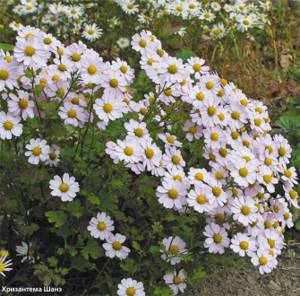
Most of the chrysanthemums we studied (Chrysanthemum naktongense, C. coreanum, C. chanetii, C. maximowiczii, C. sichotense, C. zawadskii) are located on the border of their distribution in the Russian part of the range, are represented by narrowly local peripheral populations and are considered as candidates for the list of rare species requiring urgent protection measures. Preserving their diversity at the regional level is the task of the botanical gardens of the Russian Far East.
The Chanet chrysanthemum is in critical condition . This species is quite widespread within the East Asian floristic region, Manchuria, common in Korea, Japan, China, recorded on the island. Taiwan. Researchers S.S. Kharkevich and N.N. Kachur, back in 1981, classified it as a rare, endangered species in Russia. We found isolated localities of C. chanetii, where a small number of specimens grow, which are subject to constant anthropogenic impact: the number of individuals has decreased to critical levels, and the number of habitats has also decreased. The further existence of this species is no longer possible without the use of special protection measures. Cultivated in the collection of the BSI FEB RAS, it is of interest for breeding as an early flowering, winter-hardy, low-growing species with intensive vegetative propagation.
The species Chrysanthemum naktongense, C. maximowiczii, C. zawadskii are classified as vulnerable.
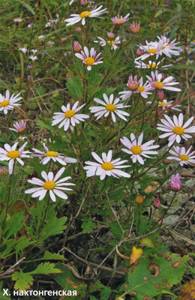
Chrysanthemum naktongense
Chrysanthemum naktongense. A perennial herbaceous plant, up to 60 cm high. The species barely enters the territory of the Russian Far East; individual habitats are noted in the southwest and south of the mainland of Primorsky Krai, about. Furugelm (Peter the Great Bay, Sea of Japan) in sparse pine forests (Pinus densiflora) and oak forests (Querqus dentata, Q. mongolica), as well as among shrubs and herbaceous vegetation on well-drained slopes. A very decorative species, studied at the Botanical Garden-Institute (BSI). Good for landscape plantings and alpine hills. Recommended for breeding as an early flowering, winter-hardy, low-growing species.
Chrysanthemum maximowiczii. The taxon has only a few loci in the Primorsky Territory and is confined to specific calciphilous plant communities located near limestone outcrops. Studied in the BSI collection. When cultivating, sufficient light is required, no turf or competition from other plants, a well-drained substrate with a neutral or slightly alkaline reaction. It is interesting for breeding as an early flowering species with a creeping bush shape. Decorative, winter-hardy, white rust-resistant chrysanthemum (Puccinia horiana).
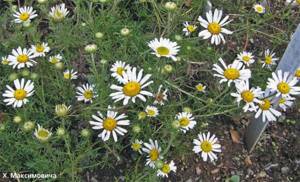
Chrysanthemum maximowiczii
It is worth noting that the reason for the rare occurrence of such species as C. naktongense, C. maximowiczii is not only the specificity of growing conditions, poor competitiveness and the periphery of the range, but also the impact of anthropogenic and pyrogenic factors, leading to even greater isolation of micropopulations and impoverishment of genetic resources.
C. maximowiczii is included in the List of Protected Plants of the Primorsky Territory (2002), the Red Book of the Primorsky Territory (2008).
Zawadskii chrysanthemum (Chrysanthemum zawadskii). A representative of the Mongolian-Siberian flora, it is found in the Central Russian Upland, in the Urals and the Far East, in Siberia and the Volga region. The species is being studied in the BSI collection. In cultivation, it forms a rosette with leaves pressed to the soil and grows into a wide clump. It is of interest for breeding as an extremely early flowering species with high winter hardiness and resistance to fungal pathogens. Among the chrysanthemums growing on the territory of the Russian Federation, this is the only representative of the genus that has a wide but fragmented range. Found only in specific ecotopes, it is a rare relict species. Listed in the Red Books of most regions of Russia.
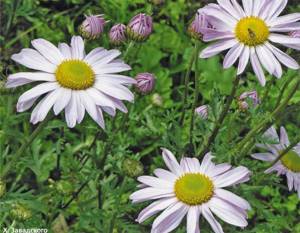
Chrysanthemum zawadskii
The least concern is the Korean chrysanthemum (Chrysanthemum coreanum). In the Primorsky Territory, the species has a local range, stretching as a narrow ribbon along the coast and the nearby islands of the Sea of Japan up to 44.5°N. w. Populations of C. coreanum are located on steep cliffs and relatively horizontal rocky surfaces; they gravitate only to sunny places, open winds and sea spray, and to sparse low-growing plant groups. The species is cultivated in the BSI and is promising for rock gardens and mini-gardens. Very decorative, forms a well-growing cushion-shaped clump. A comprehensive source of winter hardiness, compact growth, early flowering, and resistance to white rust. The species is not currently endangered or vulnerable, but is rare. It is represented by small populations, distributed in specialized niches limited in area only in the coastal zone of the Sea of Japan and on nearby islands, and has a narrow ecological amplitude. Therefore, numbers may decline due to random stressful natural or anthropogenic factors.
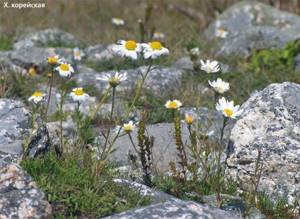
Korean chrysanthemum (Chrysanthemum coreanum)
The same category includes the high-mountain species Sikhote-Alin chrysanthemum (Chrysanthemum sichotense), which, due to its growth in hard-to-reach places, is not yet endangered. It is endemic to the highlands of Sikhote-Alin, a rare rock-talus species in the Russian Far East. Inhabits rocks in the alpine and subalpine belts. Populations are isolated from the main range. A.I. was delivered to the BSI. Nedoluzhko from Mount Olkhovaya (Partizansky district, Primorsky Krai) and E.A. Chubar - from Mount Sestra (Lazovsky district, Primorsky Krai). The possibility of introduction into culture is currently being studied.
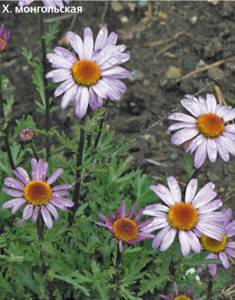
Mongolian chrysanthemum (Chrysanthemum mongolicum)
Mongolian chrysanthemum (Chrysanthemum mongolicum). A species close to C. zawadskii is a high-mountain race in relation to it. Grows in the alpine and subalpine belts. Outside Russia it is found in Northeast China and Mongolia. Exceptionally cold-resistant species. Studied at BSI. Promising for rock gardens, rockeries, rocky hills, mini-gardens. Forms dense clumps. Winter-hardy, low-growing, compactly growing species with very early flowering.
Weyrich's chrysanthemum (Chrysanthemum weyrichii). A species close to C. zawadskii (possibly its eco-geographical race on Southern Sakhalin). In 1996, T. A. Pavlova, an employee of the Central Siberian Botanical Garden (Novosibirsk), used it in crossing with C. zawadskii, resulting in interspecific hybrids.
Chrysanthemums C. weyrichii and C. mongolicum are classified as having undetermined rarity status.
Care after flowering

In order to increase the frost resistance of the bushes, in the first autumn weeks they are fed with phosphorus-potassium fertilizers for the last time during the season. Immediately after the first frost, for perennial chrysanthemums wintering in open ground (first of all, attention should be paid to varieties of Korean chrysanthemums with small inflorescences), the ground part is shortened to 10–15 centimeters from the ground surface. Then the bushes are well hilled, and the surface of the area is covered with a thick layer (from 0.3 to 0.4 m) of flying dry leaves. In regions with very frosty and little snowy winters, the mulch layer is covered with spruce branches or brushwood on top. Remember that covering the plant with material that does not allow air to pass through is extremely undesirable, because the bushes can move under it.
Wintering

Large-flowered, vigorous varieties are very thermophilic and therefore they are not able to overwinter in the ground when grown in mid-latitudes. However, they can be preserved, and many ways have been invented for this. For example, a bush is removed from the soil and, together with a lump of earth, placed in a box made of wood. Then it is transferred to a well-lit but cold room (from 2 to 6 degrees), while the air humidity should be at 80 percent. If there are few bushes, then individual containers are used for planting them. Water them systematically, making sure that the earthen ball is always a little damp.
For storage, dug up plants can be placed in a cellar, and the air temperature should be from 0 to 4 degrees. They are laid close to each other on the earthen floor along with clods of earth.
There is another way to preserve chrysanthemums. Dig a trench half a meter deep and arbitrary width in the garden plot, place the mother bushes in it and fill the distance between them with soil. The trench is not covered until frost, this will kill all pathogens of viral and fungal diseases. After the first frost, the top of the trench is covered with a wooden shield or simply boards, and you can also use slate or other hard materials. The shelter is covered with a layer of foliage, which is covered with soil. A covering material is laid on top of the earthen layer so that it is not blown away by a gust of wind; it is securely fixed. The disadvantage of this method is that you will not be able to check in winter what condition the plants are in.
It is important to know:
- small-flowered Korean chrysanthemums, as well as Russian hybrids, winter well in the garden;
- bushes that have grown in a greenhouse must be dug up in late autumn, just like large-flowered chrysanthemums, foreign hybrids and new varieties about which you know very little.
Wintering chrysanthemums in the middle zone. Website "Garden World"
